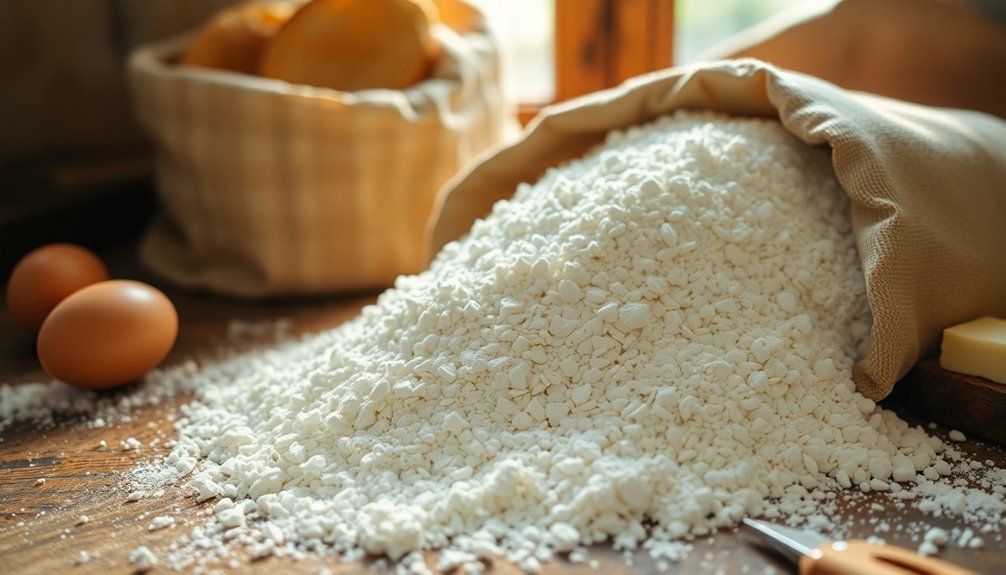When you sniff fresh flour, you're greeted by a clean, grain-like aroma that suggests it's good quality. This pleasant scent signals freshness and readiness for baking. However, if you catch a musty or rancid smell, it means the flour has likely spoiled. Spoiled flour can emit odors like cardboard or even crayon, especially in whole grain varieties. Always check for signs of spoilage before using; your baked goods depend on it! Want to discover more about flour types and storage tips? There's a lot more to know about keeping your flour fresh and safe for your culinary adventures.
Key Takeaways
- Fresh flour has a pleasant, grain-like aroma, indicating quality and freshness.
- Spoiled flour can emit musty, cardboard-like, or rancid odors, signaling deterioration.
- Whole grain flours may develop a crayon-like scent due to oil oxidation.
- Different types of flour produce distinct smells; for instance, bread flour has a slightly sweet scent.
- Regularly checking flour smell helps ensure safety and quality in baking.
Introduction

When it comes to baking, the freshness of your flour plays a crucial role, and understanding its smell can help you determine its quality. Flour's freshness directly impacts your baked goods, so you need to stay vigilant. Fresh flour typically has a clean, neutral scent, without any strong fragrances. If you notice a cardboard-like odor emanating from your white flour, it's a clear sign that it's gone bad and should be discarded.
Whole wheat flour is particularly susceptible to spoilage due to its higher fat content. It may develop a rancid smell reminiscent of crayons, indicating it's past its prime. This rancid flour can ruin your recipes, so it's essential to check regularly. Alternative flours, like almond flour, can also exhibit sour or rancid odors when spoiled.
To ensure your baking results are the best they can be, make it a habit to smell your flour before use. Any funky or unpleasant odor is a primary indicator that it's time to toss that batch. Being proactive about checking the smell of your flour can save you from disappointing baking experiences.
Description of the Smell

The scent of flour is a telltale sign of its freshness and quality. Fresh flour typically has a clean, neutral aroma that's reminiscent of grains, inviting you to bake. If you catch a whiff of something off, like a musty smell, it's a clear indication that the flour has gone bad and should be discarded. White flour, when spoiled, can emit a cardboard-like scent, signaling potential rancidity or age.
Whole grain flours have their own unique characteristics; they may develop a crayon-like odor due to the degradation of natural fats over time. This change in smell suggests that the flour isn't at its best, and using it could negatively affect your recipes.
Alternative flours, such as almond or coconut flour, can also smell rancid or sour when they spoil, which means it's time to toss them out. Always trust your nose—if the flour smells funky or musty, it's wiser to err on the side of caution. Fresh flour should be a pleasure to smell, while any unpleasant odors indicate that it's best to part ways with it.
Source and Composition

Understanding the source and composition of flour is key to appreciating its unique characteristics, including its smell. Flour primarily comes from ground grains, with wheat being the most common. Fresh flour typically has a clean, neutral scent, which is a result of its composition. Whole grain flours, however, include bran and germ, containing fats that can lead to a rancid smell if the flour experiences spoilage.
When you use alternative flours, like almond or coconut, you'll notice they offer distinct odors, often sweet or nutty, contrasting with the more neutral aroma of wheat. Fresh flour should always smell fresh and clean; any off odors, such as sour or musty scents, signal spoilage from fat degradation or moisture exposure.
Additionally, the milling process and storage conditions can greatly influence flour's smell. Freshly milled flour often has a more pronounced aroma compared to older, aged flour, which may lose its freshness over time. By understanding these sources and compositions, you can better identify the quality of the flour you're using and ensure it's fresh for your baking endeavors.
Typical Scenarios or Environments

In various kitchen environments, flour's smell can significantly vary based on storage conditions and usage. Fresh flour typically has a clean, neutral scent, reminiscent of whole grains, which is quite pleasant. However, if you leave it exposed to air for too long, you might notice a stale or musty smell indicating it's starting to spoil.
Whole wheat flour, in particular, can develop a funky smell, similar to crayons, due to the breakdown of its natural fats. If you store flour in high humidity or warm temperatures, these conditions can worsen any off odors, causing it to go rancid more quickly. You may also encounter alternative flours, like almond or coconut, which tend to produce a sour smell when they spoil, thanks to their higher fat content.
To maintain the best flour smell, it's essential to store flour properly. Keep it in an airtight container in a cool, dry place. This way, you can enjoy the fresh aroma of your flour when you're ready to bake, instead of dealing with unpleasant odors that signal spoilage.
Emotional or Cultural Associations

Baking with flour often stirs up deep emotional connections, reminding you of cherished moments spent in the kitchen with loved ones. The smell of flour can transport you back to family gatherings, where the aroma of freshly baked bread or cookies filled the air, creating a sense of warmth and comfort. In many cultures, this scent is intertwined with agricultural heritage, symbolizing the hard work of farmers and the sustenance they provide.
As you measure and mix, the anticipation of delicious treats brings a sense of excitement, reinforcing the bond between baking and emotional experiences. Different types of flour, like whole wheat or almond, have unique scents that reflect the cultural significance of traditional recipes, connecting you to your roots.
Moreover, baking fosters community, as sharing your creations allows you to celebrate cultural identity through food. Each bite carries stories, memories, and shared moments, making the simple act of baking with flour a powerful way to connect with others. Ultimately, the smell of flour does more than just signal a baking session; it evokes nostalgia, unity, and the joy of celebrating life's special moments together.
Health or Safety Considerations

When handling flour, it's crucial to be aware of its freshness to ensure your health and safety. Fresh flour typically has a clean, neutral scent, while spoiled flour can produce rancid, musty, or sour odors. These unpleasant flour smells indicate that it may have gone bad, which poses potential health risks. Consuming flour that's spoiled, especially whole grain varieties, can lead to digestive discomfort and other health issues due to mold or bacteria.
Whole wheat flour, with its higher fat content, is particularly prone to rancidity. To maintain its freshness, always store it in a cool, dark place. Regularly check for signs of spoilage, such as clumping or unusual textures, which may suggest moisture exposure. This exposure can harbor harmful microorganisms that compromise your safety.
Don't underestimate the importance of sniffing your flour and looking for visible signs of spoilage. By being proactive in assessing flour freshness, you can avoid using compromised ingredients in your baking and safeguard your health. Pay attention to those flour smells, and make sure you're using only the best for your recipes.
Final Thoughts

Understanding the importance of flour freshness can significantly enhance your baking experience. As a home cook, you might not realize how vital it is to pay attention to the smell of your flour. Fresh flour typically has a clean, neutral scent, while spoiled flour emits rancid, sour, or musty odors. If you notice any off smells, it's time to replace your flour.
Different types of flour can spoil differently; for instance, whole wheat flour may develop a crayon-like smell due to its higher fat content. Alternative flours like almond flour can also go bad, producing sour or rancid odors. Remember that storage conditions matter; exposure to air and humidity can lead to undesirable scents and spoilage.
Regularly checking the smell of your flour before using it helps ensure better baking results and food safety. When you detect any unpleasant odors, it's a clear sign that your flour has gone bad and needs replacing. By keeping an eye (and nose) on your flour, you can elevate your baking and enjoy delicious results every time. So, trust your senses and don't hesitate to discard any questionable flour!
Frequently Asked Questions
How Can You Tell if Flour Has Gone Bad?
To tell if your flour has gone bad, start by checking for any off-putting smells; if it smells rancid or musty, it's time to toss it. Next, inspect for clumps or discoloration, which could indicate moisture or mold. Whole wheat flour may emit a crayon-like odor when spoiled. If anything seems unusual compared to fresh flour, don't risk it—discard it to keep your baked goods safe and tasty.
Does Flour Have an Odour?
Yes, flour does have an odor, though it's usually quite subtle. You'll often notice a clean, neutral scent resembling fresh grain. However, if you're using whole wheat or alternative flours, be cautious—these can develop off-putting smells if they spoil. If you catch a whiff of something musty or funky, it's a sign that the flour has gone bad and should be tossed out immediately. Always trust your nose!
What Should White Flour Smell Like?
When you check white flour, it should smell clean and neutral, similar to fresh grains. If it has a cardboard-like scent, it's a sign it's spoiled and you shouldn't use it. Stale odors indicate it's gone bad from being exposed to air. Any musty or sour smells mean it's no longer suitable for baking. Regularly inspect your flour to ensure it stays fresh for up to a year when stored properly.
What Does Flour Taste Like?
When you taste flour, you'll notice that fresh white flour has a clean, neutral flavor, making it easy to mix with other ingredients. If you try whole wheat flour, you'll experience a nuttier taste due to the bran and germ. Specialty flours, like almond or coconut, add their unique flavors—almond being subtly sweet and coconut offering a mild taste. Just be cautious; spoiled flour can taste rancid or musty, affecting your baked goods.









